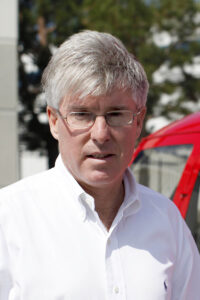At Robinson Helicopter Co. Inc. in Torrance, supply chain issues began cropping up about a year ago.
According to Kurt Robinson, the chief executive of the Torrance aircraft manufacturer, the first year of the pandemic saw the company carry large inventories of everything, so supply chain problems did not impact the firm initially.

“Obviously, over the past year or so it has impacted us quite a bit,” Robinson said. “We have seen a lot of cases of vendors missing delivery dates by wide margins.”
Playing into that is the high rejection rate of parts.
When talking with vendors about this, Robinson said he had been told that it was due to high employee turnover or a change in the type of material used to make the parts.
“We have to maintain a high level of quality, and so we have found much higher rejection rates have been occurring more and more over the last six to nine months,” Robinson added. “As we move forward, that really is our biggest concern, not just that they give us the 100 parts that they are supposed to give us but that all 100 parts are to the quality they need to be.”
Robinson Helicopters is not alone in facing what has become a global supply chain problem, which has popped up due to the Covid-19 pandemic forcing shutdowns in areas with high concentrations of manufacturers, particularly in China; increasing consumer demand; and backups at ports, especially in Southern California, home to two of the busiest ports in the world.
Additionally, there have been labor shortages in jobs key to keeping the supply chain operating smoothly.
Like Robinson Helicopter Co., Lee’s Enterprise is also seeing supply chain issues. The Chatsworth-based manufacturer founded in 1974, does aerospace work only. About 75% of it is for military customers, and 25% is for commercial aviation. It makes parts and assemblies for a variety of aircrafts, machining parts from carbon steel, stainless steel, aluminum, and other standard aircraft metals.
“We make parts that are specialty gears that go inside electromechanical actuators,” said President Tom Molnar. “So, our stuff has a lot of outside specialty processing done to it.”
After being machined at Lee’s facility, those parts are sent out for heat-treating and plating. But the firm is finding that the lead times at its heat-treaters and platers is taking longer and longer due to them being short-staffed and experiencing a surge in work, Molnar said.
David Fisher, owner of S&H Machine, a Burbank aircraft parts manufacturer, also sends his parts for commercial aircraft out to be heat-treated and plated. He has hundreds of vendors working for the company, and their cost of doing business has increased, so they raised their prices, he said.
“Which is putting a tremendous financial burden on shops like mine because we are locked into contracts and fixed pricing for many years so that is making it challenging for companies like us,” he said.
Due to supply chain and labor shortages, S&H is not taking on new work. Instead, it concentrates on the legacy work it has always done, Fisher said.
“I am turning away business I have not seen before because I don’t have the capacity to take it on right now,” he added.
Limited quantities
David Goodreau, president of the Small Business Aerospace Industry Coalition, a Glendale-based national nonprofit network of independently owned small businesses manufacturing and supplying military aerospace spare parts, components and assemblies, said the coalition sold some manufacturing equipment, which included some simulators for CNC (computer numerical controlled) machines.
Another company purchased three of the simulators for a couple of thousand dollars and then did something interesting with them.
Because computer chips are limited in quantity due to supply chain issues, the company took them out of the simulators and put them into other equipment, Goodreau said.
“You have instances like that where people are making lemonade out of lemons,” he added.
For Molnar, of Lee’s Enterprise, the opposite is true, as everything is taking longer to get done.
Customers are ordering more parts ahead of time because of the long lead time needed to process the parts, he said.
So in addition to ordering more parts to keep their prices lower, they are ordering parts even sooner, Molnar added.
“I feel like it’s creating an artificial backdrop of insanely spiking demand when there is not enough supply to handle it,” he said.
For Robinson, it is a very simple equation: “If you don’t have parts, you can’t build helicopters.”
Lower optimism
Sikich, a Naperville, Illinois-based consultancy and technology firm, released last week its latest Sikich Industry Pulse, a report on the manufacturing and distribution industry. The survey results were compiled from responses from 100 manufacturing and distribution executives questioned in June.
The survey showed that only 58% of manufacturing and distribution executives rated their optimism at a seven or higher on a scale of one to 10. This comes a year after 81% of executives rating their optimism at a seven or higher.
Supply chain and labor-shortage issues also had a role in how manufacturers are falling behind in meeting the demands of their customers.
Forty-three percent of the executives surveyed said that supply-chain obstacles causing a material shortage was the number one reason why their companies could not meet demand. Thirty-nine percent named the labor shortage for not meeting customer demand.
But Fisher, of S&H Machine, was not pessimistic about the future of his business.
“I need to find people and I need to find ways of automating,” Fisher said. “The fact that I have work is a good thing. Yeah, raw materials shortages are a problem, and lack of people is a problem. But if you have work, you have hope.”
Fisher said he felt good about the future and was confident that he would make it through this tough period.
“I have less competition than I did before, so that is a good thing,” he added. “There are some nice things that are there.”
